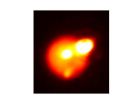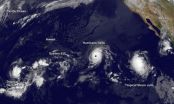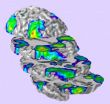(Press-News.org) Boulder, Colo., USA – How long does it take for natural Earth processes to form hydraulic fractures? Is the formation driven by sediment compaction, oil and gas generation, or something else? What role do these natural fractures play in modern hydraulic fracturing production? A new GSA BULLETIN study by András Fall and colleagues from The University of Texas at Austin, Virginia Tech, and ExxonMobil addresses these questions, and the article is open-access online.
The process of fracture formation by a natural increase in pore-fluid pressure has previously been referred to as natural hydraulic fracturing. Researchers work to understand these fractures through examination of fluid inclusions trapped in minerals within the fractures. In this study, Fall and colleagues conclude that natural hydraulic fractures formed over time spans of 33 to 35 million years, driven by the slow generation of natural gas.
Natural fractures provide important pathways for the flow of water, natural gas, and oil in geologic formations, including unconventional tight-gas sandstone oil and gas reservoirs targeted for production by hydraulic fracturing. These fractures play an essential role during well completion and production by connecting pores in the reservoir rock storing oil and gas to the hydraulic fracture and wellbore that allow production. "Sweet spots," or zones of higher than average permeability, have been attributed to the presence of these open fractures.
Successful prediction of zones of increased fracture abundance provides an opportunity to minimize drilling and completion costs as well as the environmental footprint of production. Successful prediction of natural fracture occurrence and their hydraulic properties requires models of fracture formation that are based on realistic mechanical, hydraulic, and chemical principles that can be tested against core, well-log, and production data.
This study is open-access (free) online at http://dx.doi.org/10.1130/B31021.1.
FEATURED ARTICLE
Natural hydraulic fracturing of tight-gas sandstone reservoirs, Piceance Basin, Colorado
A. Fall et al., Bureau of Economic Geology, Jackson School of Geosciences, The University of Texas at Austin, Austin, Texas 78758, USA. Published online on 30 July 2014; http://dx.doi.org/10.1130/B31021.1. OPEN ACCESS online.
Other GSA BULLETIN articles (see below) cover such topics as
1. Deep-seated landslides, river incision, and climate change in Waipaoa Catchment, East Coast North Island, New Zealand;
2. Ancient water (meteoric water) in Snake Range rocks, Nevada, USA; and
3. A seismotectonic model that accounts for most of historical and instrumental seismicity in the Po Plain of northern Italy.
GSA BULLETIN articles published ahead of print are online at http://gsabulletin.gsapubs.org/content/early/recent; abstracts are open-access at http://gsabulletin.gsapubs.org/. Representatives of the media may obtain complimentary copies of articles by contacting Kea Giles.
Sign up for pre-issue publication e-alerts at http://www.gsapubs.org/cgi/alerts for first access to new journal content as it is posted. Subscribe to RSS feeds at http://gsabulletin.gsapubs.org/rss/.
Please discuss articles of interest with the authors before publishing stories on their work, and please make reference to GSA Bulletin in your articles or blog posts. Contact Kea Giles for additional information or assistance.
Non-media requests for articles may be directed to GSA Sales and Service, gsaservice@geosociety.org.
Hillslope response to climate-modulated river incision in the Waipaoa Catchment, East Coast North Island, New Zealand
E.L. Bilderback, Geologic Resources Division, National Park Service, P.O. Box 25287, Denver, Colorado 80225, USA. Published online on 30 July 2014; http://dx.doi.org/10.1130/B31015.1.
Hillslope response to climate-modulated river incision in the Waipaoa Catchment, East Coast North Island, New Zealand investigates how hillslopes respond to river incision and climate change in an uplifting landscape over a glacial-interglacial cycle. High-resolution topographic data sets combined with field mapping and tephrochronology indicate that hillslopes adjusted to rapid river incision through the initiation and reactivation of deep-seated landslides. Deep-seated landslides can occupy over 30% of the surface area of the areas studied. Air fall tephra from multiple volcanic eruptions allows the timing of the onset of widespread hillslope adjustment to be bracketed between circa 14,000 and 9,500 years ago. Using results from landform tephrochronology and mapping, a conceptual time series of hillslope response to uplift and climate change-induced river incision over the last glacial-interglacial cycle is presented.
Meteoric water circulation in a rolling-hinge detachment system (Northern Snake Range core complex, Nevada)
A. Gébelin et al., Biodiversity and Climate Research Centre (BiK-F) and Senckenberg, Senckenberganlage 25, 60325 Frankfurt/Main, Germany. Published online on 30 July 2014; http://dx.doi.org/10.1130/B31063.1.
Old water in deformed rocks documents how the Nevada mountains formed in the past. Analysis of the composition of surface-derived fluids shows that water sourced at high elevation was able to penetrate to deep levels of the continental crust. So-called metamorphic core complexes in the Basin and Range of Nevada contain zones of deformation that channeled these waters and hence represent robust archives for (paleo-) fluid flow. In the case of the Snake Range, such fluid flow was intimately coupled to the permeability structure in the upper crust and was associated with active faults that over time were rendered inactive during exhumation.
Evidence for late Alpine tectonics in the Lake Garda area (northern Italy) and seismogenic implications
G. Scardia et al., Instituto Oceanográfico, Universidade de São Paulo, Praça do Oceanográfico 191, 05508-120 São Paulo, SP, Brazil. Published online on 30 July 2014; http://dx.doi.org/10.1130/B30990.1.
The Po Plain in northern Italy is a densely inhabited area, characterized by low deformation rates and damaging earthquakes with millennial‐scale recurrence time. By integrating seismic reflection data and detailed geologic mapping it has been possible to document the Plio-Pleistocene tectonic evolution of the Southern Alps. Stratigraphic and structural data allowed for the definition of three main tectonic events and new active faults have been identified. All the gathered data have been integrated in a seismotectonic model, which accounts for most of historical and instrumental seismicity in the Po Plain.
Detrital zircon provenance of the Late Cretaceous-Eocene California forearc: Influence of Laramide low-angle subduction on sediment dispersal and paleogeography
G.R. Sharman et al., Dept. of Geological and Environmental Sciences, Stanford University, Stanford, California 94305, USA. Published online on 30 July 2014; http://dx.doi.org/10.1130/B31065.1.
Glenn R. Sharman and colleagues present a synthesis of new and existing radiometric ages of individual sand grains (zircon) from sandstone that was deposited between 100 and 40 million years ago in ocean basins along the western margin of North America (Oregon, California, and Baja California). Their study shows how the source of the sand changed over time in response to plate tectonics. In particular, an episode of low-angle plate subduction and associated oceanic plateau collision with southern California had a major influence on how landscapes evolved along the western margin of North America. For example, Sharman et al. show that rivers that emptied into the paleo-Pacific ocean migrated eastward over time in response to a redistribution of topography along the margin following oceanic plate collision.
Timing and significance of gabbro emplacement within two distinct plutonic domains of the Peninsular Ranges batholith, southern and Baja California
D.L. Kimbrough et al., Dept. of Geological Sciences, San Diego State University, San Diego, California 92182-1020, USA. Published online on 30 July 2014; http://dx.doi.org/10.1130/B30914.1.
Evaluating the crucial role postulated for mantle-derived mafic magmas in the formation of Cordilleran continental batholiths requires well-determined igneous crystallization ages from gabbro intrusions as well as petrologic data reflecting possible mantle source heterogeneities and/or variations in subcrustal processes. This paper by David L. Kimbrough and colleagues establishes the chronological framework for gabbro emplacement in one of the best known Cordilleran batholith of the Americas, the Peninsular Ranges batholith southern and Baja California, and thereby contributes to fundamental questions related to the formation of continental crust.
Three-dimensional (3-D) finite strain at the central Andean orocline and implications for grain-scale shortening in orogens
N. Eichelberger, Dept. of Geosciences, Princeton University, Princeton, New Jersey 08544, USA; and N. McQuarrie, Dept. of Geology and Planetary Science, University of Pittsburgh, Pittsburgh, Pennsylvania 15260, USA. Published online on 30 July 2014; http://dx.doi.org/10.1130/B30968.1.
The magnitude of contraction, or shortening, accommodated in active mountain ranges is a critical observation for understanding how mountain belts evolve over geologic time. Shortening is often estimated from cross-section models that are constrained by geologic map patterns and fault geometries at scales of kilometers or greater. In addition, micro-scale strain data from several ranges show that regionally significant amounts of shortening can also occur at the grain-scale (millimeters or less). Here, Nathan Eichelberger and Nadine McQuarrie present new micro-scale strain data from the Bolivian Andes that indicates that micro-scale shortening was a negligible part of the deformation budget. By comparing variables such as deformation temperature and rock strength between mountain ranges, Eichelberger and McQuarrie explore what factors may have limited grain-scale shortening in the Bolivian Andes. It appears that low deformation temperatures and abundant-but-weak shale favored the development of faults rather than grain-scale shortening. Globally, this implies that pre-deformation basin sedimentology of may later influence mountain belt evolution.
Age and provenance of the Cryogenian to Cambrian passive margin to foreland basin sequence of the northern Paraguay Belt, Brazil
B. McGee et al., Centre for Tectonics, Resources and eXploration (TRaX), School of Earth and Environmental Sciences, B09, Mawson Building, The University of Adelaide, Adelaide, SA 5005, Australia. Published online on 30 July 2014; http://dx.doi.org/10.1130/B30842.1.
This article by Ben McGee and colleagues presents data from a mountain belt in central-western Brazil that indicate that collision between local tectonic plates and subsequent mountain building occurred later than previously thought. The Paraguay Mountain Belt in central South America developed in response to the collision between the Amazonian Craton, the São Francisco Craton and the Paranapanema Block. The alleged ~620 million year age of mountain building has recently been questioned by geologic data that indicate the closing stages of mountain building occurred well into Cambrian time. The timing of deposition and source areas for these sedimentary rocks overlying the Amazonian Craton are investigated here using integrated U-Pb and Hf isotope data of small minerals called zircons from rocks within this sequence. Ben McGee and colleagues analyzed 742 detrital zircon ages from samples taken from the base to the top of this sedimentary succession. Maximum depositional ages from the uppermost part of this sequence of rocks, the Diamantino Formation, indicate that final deposition began no earlier than 560 (plus or minus 13) million years ago and possibly as young as the Cambrian. Given that zircon inheritance in these rocks continues up until this age and that known Amazonian Craton ages are older than ~950 million years, McGee et al. consider other potential sources for these sediments. This is achieved by integrating the U-Pb detrital zircon data with Hf isotopic data from these zircons. The Hf signature is consistent with a predominantly Amazonian source until the early-Neoproterozoic at which point the signal becomes significantly more evolved. These data, when combined with other evidence discussed here, are consistent with an ocean to the east of the present-day Amazonian Craton that didn't close until the latest Ediacaran/Cambrian.
INFORMATION:
http://www.geosociety.org/
How long does it take to make a natural fracture?
GSA Bulletin content published online on 30 July 2014
2014-08-04
ELSE PRESS RELEASES FROM THIS DATE:
Bottling up sound waves
2014-08-04
There's a new wave of sound on the horizon carrying with it a broad scope of tantalizing potential applications, including advanced ultrasonic imaging and therapy, acoustic cloaking, and levitation and particle manipulation. Researchers with the U.S. Department of Energy (DOE)'s Lawrence Berkeley National Laboratory (Berkeley Lab) have developed a technique for generating acoustic bottles in open air that can bend the paths of sound waves along prescribed convex trajectories.
Sound waves move much like light waves. They travel on a straight path but this path - through ...
Extreme volcanism: Image captures 1 of the brightest volcanoes in the solar system
2014-08-04
During the middle of 2013, Jupiter's moon Io came alive with volcanism. Now, an image from the Gemini Observatory captures what is one of the brightest volcanoes ever seen in our solar system. The image, obtained on August 29, reveals the magnitude of the eruption that was the "grand finale" in a series of eruptions on the distant moon. Io's volcanism is caused by the tidal push-and-pull of massive Jupiter, which heats the satellite's interior – making it our Solar System's most volcanically active known body.
According to University of California Berkeley (UCB) astronomer ...
Earlier intervention for common form of heart attack linked to improved survival
2014-08-04
Changes in the treatment of the most common form of heart attack over the past decade have been associated with higher survival rates for men and women regardless of age, race and ethnicity, according to a UCLA-led analysis.
But the study also suggests that there is room for improvement in how current treatment guidelines are applied among specific patient groups.
The researchers reviewed records for 6.5 million people who were treated for heart attacks between 2002 and 2011. The analysis was among the first and largest national studies to assess the impact of the trend ...
Anorexia fueled by pride about weight loss
2014-08-04
Positive emotions – even those viewed through a distorted lens – may play an exacerbating role in fueling eating disorders like anorexia nervosa, which has a death rate 12 times higher for females between the ages of 15 and 24 than all other causes of death combined, according to a Rutgers study.
In research published in Clinical Psychological Science, Edward Selby, an assistant professor in the Department of Psychology, School of Arts and Sciences, measured over a two week period the emotional states of 118 women between the ages of 18-58 being treated for anorexia nervosa. ...
Satellite view of a hyperactive Eastern and Central Pacific Ocean
2014-08-04
NASA and NOAA satellites have been supplying forecasters with data developing tropical cyclones in the Eastern and Central Pacific Ocean and over the last several days. There have been as many as five tropical systems at the same time. On Monday, August 4, there were three tropical systems stretching from west to east: Tropical Depression Genevieve in the Central Pacific, Hurricane Iselle and Tropical Storm Julio in the Eastern Pacific.
Tropical Depression Genevieve May Strengthen
On August 4, Tropical Depression Genevieve was located about 930 miles (1,495 km) southwest ...
Version 2.0 of Prostate Cancer Risk Calculator now online, complete with emojis
2014-08-04
SAN ANTONIO (August 4, 2014) — A calculator to help men and their doctors assess their risk of prostate cancer, developed at the UT Health Science Center, has had a major upgrade to enhance how men and their physicians better understand a man's risk of prostate cancer.
A description of the update's needs and benefits is described by the Health Science Center authors in a viewpoint published online Monday in the Journal of the American Medical Association.
"The prostate cancer risk calculator has been updated using current risk factors and a better interface; the current ...
Newly discovered juvenile whale shark aggregation in Red Sea
2014-08-04
Whale sharks (Rhincodon typus)—which grow more than 30 feet long—are the largest fish in the world's ocean, but little is known about their movements on a daily basis or over years. A newly discovered juvenile whale shark aggregation off Saudi Arabia is giving researchers a rare glimpse into the lives of these gentle giants.
Scientists from the Woods Hole Oceanographic Institution (WHOI) and colleagues from the King Abdullah University of Science and Technology (KAUST) and Massachusetts Division of Marine Fisheries report on the movements of whale sharks tagged at the ...
Horses communicate with their eyes and mobile ears
2014-08-04
Horses are sensitive to the facial expressions and attention of other horses, including the direction of the eyes and ears. The findings, reported in the Cell Press journal Current Biology on August 4, are a reminder for us humans to look beyond our own limitations and recognize that other species may communicate in ways that we can't, the researchers say. After all, human ears aren't mobile.
"Our study is the first to examine a potential cue to attention that humans do not have: the ears," says Jennifer Wathan of the University of Sussex. "Previous work investigating ...
Declining intelligence in old age linked to visual processing
2014-08-04
Researchers have uncovered one of the basic processes that may help to explain why some people's thinking skills decline in old age. Age-related declines in intelligence are strongly related to declines on a very simple task of visual perception speed, the researchers report in the Cell Press journal Current Biology on August 4.
The evidence comes from experiments in which researchers showed 600 healthy older people very brief flashes of one of two shapes on a screen and measured the time it took each of them to reliably tell one from the other. Participants repeated ...
Prenatal alcohol exposure alters development of brain function
2014-08-04
In the first study of its kind, Prapti Gautam, PhD, and colleagues from The Saban Research Institute of Children's Hospital Los Angeles found that children with fetal alcohol spectrum disorders (FASD) showed weaker brain activation during specific cognitive tasks than their unaffected counterparts. These novel findings suggest a possible neural mechanism for the persistent attention problems seen in individuals with FASD. The results of this study will be published in Cerebral Cortex on August 4.
"Functional magnetic resonance imaging (fMRI) has been used to observe ...
LAST 30 PRESS RELEASES:
Structure of dopamine-releasing neurons relates to the type of circuits they form for smell-processing
Reducing social isolation protects the brain in later life
Keeping the heart healthy increases longevity even after cancer
Young adults commonly mix cannabis with nicotine and tobacco
Comprehensive review illuminates tau protein's dual nature in brain health, disease, and emerging psychiatric connections
Book prepares K-12 leaders for the next public health crisis
Storms in the Southern Ocean mitigates global warming
Seals on the move: Research reveals key data for offshore development and international ecology
Sports injuries sustained during your period might be more severe
World's first successful 2 Tbit/s free-space optical communication using small optical terminals mountable on satellites and HAPS
Can intimate relationships affect your heart? New study says ‘yes’
Scalable and healable gradient textiles for multi‑scenario radiative cooling via bicomponent blow spinning
Research shows informed traders never let a good climate crisis go to waste
Intelligent XGBoost framework enhances asphalt pavement skid resistance assessment
Dual-function biomaterials for postoperative osteosarcoma: Tumor suppression and bone regeneration
New framework reveals where transport emissions concentrate in Singapore
NTP-enhanced lattice oxygen activation in Ce-Co catalysts for low-temperature soot combustion
Synergistic interface engineering in Cu-Zn-Ce catalysts for efficient CO2 hydrogenation to methanol
COVID-19 leaves a lasting mark on the human brain
Scientists use ultrasound to soften and treat cancer tumors without damaging healthy tissue
Community swimming program for Black youth boosts skills, sense of belonging, study finds
Specific depressive symptoms in midlife linked to increased dementia risk
An ‘illuminating’ design sheds light on cholesterol
Who is more likely to get long COVID?
Study showcases resilience and rapid growth of “living rocks”
Naval Research Lab diver earns Office of Naval Research 2025 Sailor of the Year
New Mayo-led study establishes practical definition for rapidly progressive dementia
Fossil fuel industry’s “climate false solutions” reinforce its power and aggravate environmental injustice
Researchers reveal bias in a widely used measure of algorithm performance
Alcohol causes cancer. A study from IOCB Prague confirms damage to DNA and shows how cells defend against it
[Press-News.org] How long does it take to make a natural fracture?GSA Bulletin content published online on 30 July 2014






